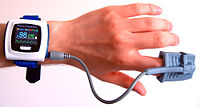
Photo from wikipedia
INTRODUCTION The measurement of blood pressure (BP) and the management of hypertension in patients with continuous-flow ventricular assist devices (CF-VADs) can present unique challenges. Patients with CF-VADs often do not… Click to show full abstract
INTRODUCTION The measurement of blood pressure (BP) and the management of hypertension in patients with continuous-flow ventricular assist devices (CF-VADs) can present unique challenges. Patients with CF-VADs often do not have a palpable pulse, and therefore traditional blood pressure measurement by auscultation or automated cuff is less reliable. We tested the efficacy of blood pressure estimation using sphygmomanometry combined with finger pulse oximetry only after a hemodynamic optimization was effected to make the values estimated approximately similar to mean arterial pressure. METHODS Fifteen consecutive patients with a mean age of 57.8 ± 11.2 years were implanted with HeartMate 3 between November 2015 and March 2017. All patients underwent pump speed optimization by conducting a ramp test during right heart catheterization. The patients were prospectively studied during the follow-up period and mean arterial pressure was estimated using 3 different methodologies: Doppler ultrasound, pulse oximeter, and automated blood pressure cuff. For each method 3 consecutive evaluations were conducted during 3 follow-up visits. RESULTS For each patient, 9 different evaluations were obtained (3 for each method). The overall success rate was 100% for blood pressure assessment conducted with Doppler ultrasound and pulse oximeter and 80%-87% for automated monitor evaluations. The first 2 methodologies were 100% successful, while the third was 60% successful. Pearson's correlation analyses for the Doppler ultrasound and pulse oximeter measurements showed a good correlation when evaluations conducted with the same method were compared. A high variability emerged between estimations obtained by using an automated monitor and a poor correlation was found when this method was compared to the Doppler ultrasound and pulse oximeter measurements. CONCLUSION According to our results, the pulse oximeter method showed a high success rate and a good correlation level with the standard procedure. Our data encourage the use of oximeters for domiciliary blood pressure assessment in patients implanted with a continuous flow device.
Journal Title: Transplantation proceedings
Year Published: 2019
Link to full text (if available)
Share on Social Media: Sign Up to like & get
recommendations!